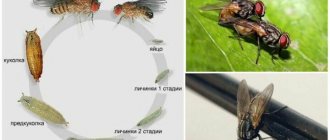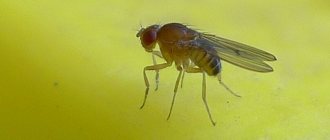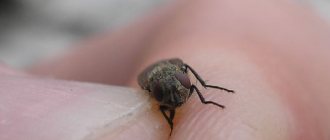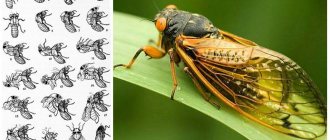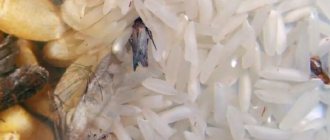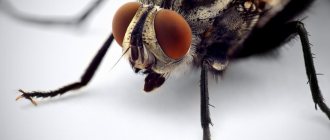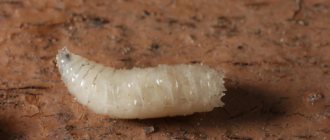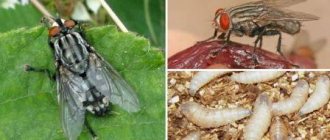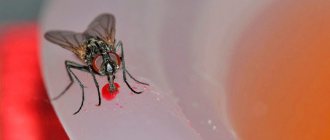Flies constantly annoy humans during the warm season. And all measures to combat them generally give a short-term effect, since these insects are able to penetrate into an apartment or house without much difficulty.
The main function of flies is reproduction. Therefore, females lay eggs in any suitable places and after some time larvae emerge from them. And since maggots feed on many foods that humans eat, the likelihood of them being swallowed is quite high. Therefore, it is worth understanding what this means for human health.
Where do flies lay their eggs?
Females initially worry about future offspring. Therefore, flies lay eggs where the larvae can fully feed and develop immediately after birth, since without food they die after 2 days.
In nature, this is usually organic waste of a liquid consistency, since the mouthparts of maggots are not designed for solid food. At home, the fly tries to lay eggs on human food.
Receptors on the legs, which act as an organ of touch, help the insect find the optimal place for its offspring. Then the fly uses its proboscis to check the consistency and taste of the product, and only after that it lays eggs.
Contaminated Meat
Suitable for this:
- meat;
- fish;
- fruits;
- vegetables;
- offal;
- cottage cheese;
- cheese.
Ready-made meals based on cereals can also serve as food for offspring. In order for an insect to lay eggs, it is quite enough to leave food on the table for a short time during the warm period of the year.
Intestinal myiasis
When a person becomes infected with fly larvae, intestinal myiasis occurs. The larvae live on or inside a person and survive by feeding on his tissues.
Intestinal myiasis is a type of myiasis that can occur when a person eats a fly larva that survives in the gastrointestinal tract. Some people with intestinal myiasis do not experience any symptoms and may only realize they are infected after noticing larvae in their stool.
However, here are some symptoms of intestinal myiasis that you may experience:
- abdominal pain
- nausea and vomiting
- itching in the anus
- bleeding from the rectum
Myiasis is not common in developed countries and occurs primarily in tropical and subtropical countries, including Africa and South America. However, a person may develop myiasis as a result of traveling to these countries.
Types of larvae
There are about 3.5 thousand species of flies in nature, but only a few of them penetrate into a person’s home. Finding favorable conditions here, they lay eggs, from which larvae subsequently emerge.
Maggot
In addition to the larvae of ordinary houseflies, the following species can be found in an apartment:
- Maggot . The length of the insect reaches 15 mm. This species is the offspring of the blue carrion fly. Maggots can appear in meat and fish.
- Gozzer . This is the larva of the black-headed blue fly. Characterized by rapid pupation. The size of the insect at the last stage of development reaches 20 mm.
- Gordini . The maggot of a gray blowfly, the size of which reaches 20-25 mm. The larva quickly pupates.
- Pinka . This species is the offspring of the green blowfly. The body length of the larvae does not exceed 10 mm.
- FIFA . Lucilia fly maggot. Belongs to the category of frost-resistant species. The length of the larva does not exceed 12 mm.
Flukes
Flukes have a leaf-shaped shape and are characterized by a high ability to reproduce at different periods of the life cycle. Reproduction of worms is possible not only sexually with fertilization, but also without it. In addition to suckers, worms have many hooks and spines, due to which they are securely attached to the mucous membranes of organs.
Common pathologies caused by flukes:
- fascioliasis;
- opisthorchiasis;
- paragonimiasis.
Fascioliasis
Fascioliasis occurs when the liver or gallbladder is damaged by the liver fluke. Infection mainly occurs through consumption of vegetables that have been irrigated with water from open reservoirs.
In addition to the standard signs of parasite infection, a person may experience asthmatic attacks, which are accompanied by difficulty breathing, redness of the face, dilated pupils, and tachycardia. If an adult has caused obstruction of the bile ducts, obstructive jaundice develops. Signs of pathology:
- cramping pain in the right hypochondrium;
- yellowing of the skin;
- fever;
- colorless feces.
Opisthorchiasis
The causative agent of the disease is the cat fluke. The name of the parasite is due to the fact that in addition to humans, it often affects cats and other mammals that eat fish.
As a rule, the cat fluke affects the liver and pancreas, causing inflammatory processes in the organs. Symptoms vary and depend on the number of parasites. The patient may experience:
- symptoms of intoxication;
- fever,
- hives;
- itchy skin;
- pain in muscles, joints, right hypochondrium.
In some cases, helminths cause enlargement of lymph nodes and the development of jaundice. The chronic form of the pathology often leads to hepatitis and cirrhosis of the liver.
Paragonimiasis
The culprit of the disease is a pulmonary fluke, which enters the human body with infected crustaceans. In Russia, the foci of paragonimiasis are the rivers of the Far East.
First, the parasite penetrates the human intestine, then into the abdominal cavity. The end point of his journey is lung tissue. In addition, the worm is able to penetrate the brain and affect the central nervous system.
Specific signs of parasitic infestation of the lungs:
- pain in the chest;
- cough with sputum, which may contain pus and blood;
- fever.
In some cases, helminths cause disruption of the ventilation function of the lungs and gas exchange during breathing.
What do they look like?
Regardless of the type of fly, their eggs and larvae are similar in many ways. The difference can only be in the size and shades of color of the larvae. When magnified, a fly egg resembles the color and shape of a grain of rice. Its size is about 1-1.5 mm.
The fly larva is born approximately 2 mm in size. For each molt, it doubles in size and at the pre-pupation stage elongates to its maximum size. The weight of an adult maggot is 22-27 g, depending on the species.
The larvae can be gray, beige or yellowish in color. They have a segmented elongated body. Insects move due to false legs in the form of convex growths, which are located on the sides of the body. The insect's body consists of a head capsule, thoracic and abdominal regions. In the front part there is a mouthparts with retractable hooks. The larval chest consists of 3 segments, and the remaining 10 belong to the abdominal section.
The prepupa of a fly initially has the same color as the larva. But as she gets older, her skin hardens and darkens. The insect pupa has the shape of a barrel with pronounced transverse circular notches. It is dark brown in color.
Signs of food poisoning
Symptoms of poisoning are largely similar, regardless of the cause. They are distinguished by intensity and severity depending on the type of toxic substance, age (poisoning in an adult is easier than in children and the elderly) and the amount eaten. However, signs of an inflammatory process in the walls of the intestines and stomach, as well as manifestations of general intoxication of the body, almost always occur.
Signs of poisoning:
Read also: DIY fashion accessories
- chills, diarrhea, nausea with vomiting;
- feeling unwell, malaise, weakness;
- bloating, painful cramping sensations;
- rise in temperature (usually small).
Severe poisoning, for example, with botulinum toxin, is accompanied by symptoms of damage to the nervous system:
- dry mouth and difficulty swallowing;
- muscle weakness;
- blurred vision, double vision;
- loss of coordination of movements.
What happens if you eat a fly larva?
In most cases, if you eat a fly larva, nothing bad happens. However, another development of events is also possible, which will cause serious health problems.
Myases
This parasitic disease can be caused by the larvae of the gray blowfly and wohlfarth fly. This occurs against the background of a weakened immune system and disruption of the digestive system. In this case, if a person eats a larva, it is not processed in the stomach, but enters the systemic bloodstream and any internal organ. As a result, this leads to the development of an inflammatory process and can cause weakness, fever and other health complications.
Miaz
Intestinal myiases
This type of disease develops when larvae deposited by a fly enter the human intestine. This causes inflammation of the organ mucosa, accompanied by pain in the abdomen, diarrhea, and vomiting.
The disease can develop if you swallow the larva of a housefly, housefly, blue blowfly, or cheese fly. This occurs with reduced acidity of gastric juice and aerophagia.
In most cases, the larvae die in the human body and come out with vomiting and excrement; in rare cases, surgical intervention is required.
Intestinal myiasis
Salmonella
Swallowed fly larvae can be carriers of salmonellosis. This infectious disease is accompanied by a sharp increase in body temperature, diarrhea, fever, and loose stools.
In most cases, the disease does not require special treatment and goes away on its own with diet and drinking plenty of fluids.
Salmonella
Consequences
If a person accidentally swallows an adult fly or eggs of a fly, then usually nothing bad happens. Insects consist of protein and chitinous shell, which are easily broken down by gastric juice or excreted naturally.
Some people have an individual reaction in their digestive tract to fly eggs. The painful condition manifests itself in the form of:
- stomach ache;
- nausea;
- vomiting;
- stomach upsets.
If symptoms persist for more than 2–3 hours, and health worsens, then call a doctor as soon as possible for the victim.
The real danger to people is the larvae of gray blowflies, which cause myiases - parasitic diseases of the skin, intestines, stomach, respiratory system, vision, and hearing. However, such a lesion is typical for countries in Africa and South America, where this type of fly lives.
Under normal conditions, even if you swallow a fly, its eggs or larvae, it will not have any serious consequences for the body.
Fighting fly larvae
To prevent the appearance of larvae in the house, you need to keep it clean so that flies cannot lay eggs. It is necessary to take out the trash in a timely manner, hide food in the refrigerator, put away pet food and equip windows with protective nets.
Maintain cleanliness
It is also necessary to take into account that for the development of maggots, a temperature within +12...300C is required. If you are not sure of the quality of the products, you need to heat treat them. The larvae die at temperatures above +500C.
Symptoms of teniarinhoz in children
And the younger the child, the more severe the symptoms.
Most infected children have severe pain in the navel or other areas of the abdomen, which may migrate. Often the child himself indicates that the pain is accompanied by strange sounds in the lower abdomen (noise, rumbling).
Severe pain in the navel area
Older children often experience belching after eating, paroxysmal nausea, and loss of appetite. In severe cases of the disease, exhaustion and lack of vitamins in the body are observed, which causes additional symptoms:
- dry mucous membranes, thirst;
- redness of the tongue;
- muscle weakness, muscle spasms;
- paresthesia.
Children often suffer from digestive disorders and increased salivation.
Sometimes parents complain that their child has become irritable, apathetic, inattentive, and has trouble sleeping.
In the future, signs of chronic poisoning and allergies may appear.
Do people intentionally eat fly larvae?
Sardinian cheese Katzumarza has a unique pungent taste. This is achieved due to the presence of fly larvae in its composition. According to the technological process, at an early stage of its production, it is necessary to remove the top crust to attract the attention of flies. Penetrating inside the cheese, they lay eggs, and the larvae live and feed in it for several months. It is the excrement of maggots that gives the final product its unique taste.
However, the European Community for Food Safety has now banned the sale of Katsumartsa cheese, citing a high risk to human health.
Tags
your body. part of the body. throughout the body the patient swallowed a foreign body; call a doctor to get the foreign body. during the appointment
informationmedicalhealthyesophagusdayconsultationgynecologyservicesintestinaldiseasesquestionslarynxtherapyrulesswallowingaftermosquitodiagnosticsdayscentersurgeonmorefirstyeararticlesmucosafalltracheachildcalethinonatalchildkinlegisnewsnecessaryinfectionsitsallprecautionarytreatmentcasesactionslifestomachtomselfneurologyworkchildrenpartdangerous onlyspecialistsclinicwhichminashbitesmaterialpreventionwallgastroenterologistrespiratorydocumentsdoctorbatteryinternationalultrasoundfight
Do cockroaches grow in household appliances?
Good afternoon. Cockroaches have taken up residence in my irreplaceable multicooker. I tried everything I could to get them out, but to no avail. I would like to hear expert advice on how to quickly get rid of such a neighborhood?
Expert's answer:
Can cockroaches live in household appliances? The answer is yes. Such situations occur frequently. Whiskered parasites are attracted to a comfortable, warm climate and high humidity. Most often, they crawl into the indoor unit with electronics and begin to multiply there.
How to kill cockroaches in a slow cooker?
There are many different drugs to combat “mustachioed neighbors.” If your goal is to drive them out of a household appliance, and not to remove them, then you can use all kinds of repellers, the use of which will solve only part of the problem. The cockroaches will leave the slow cooker and move to another place.
To remove insects and forget about them, you will need to disassemble the device and treat the accumulation areas with a special product. After all parasites have been destroyed, the structural elements must be thoroughly cleaned with a disinfectant, dried and put back together.
Are there traditional methods?
For those who do not want to use chemicals, but want to get rid of cockroaches in a slow cooker, they can use the simplest method - freezing and then cleaning the equipment. In winter, you can put the multicooker in the cold for several days. In summer you will have to use the freezer.
Can bedbugs chew through tape?
Not long ago, a neighbor living next door bought a sofa. She brought bedbugs into the apartment along with the furniture. I'm worried that insects may appear in my apartment. I want to find out how the bug bites and whether it is possible that the insect will bite through the tape and get through the wall. Tell us in more detail.
Expert's answer:
Upon careful examination, a bedbug bite on a human body is clearly visible. Red spots appear on the skin with a small hole inside, which the bug leaves with its sharp proboscis. Bloodsuckers bite through tissue and get to the blood vessel to get enough blood.
Most often, bite marks resemble tracks. The most likely places for bites are the back, face, and perineal area. The victim does not feel when she is bitten, because small bloodsuckers release a specific anesthetic substance into the blood. After several hours, the affected area begins to itch.
Bedbugs do not bite through the skin; they pierce it with a thin proboscis, like a sharp needle. They have no need to bite tape, wallpaper, or clothes that can become an obstacle on the way to a person. They slowly crawl to another place, avoiding all obstacles on their way. One drink of blood is enough for 7 days of existence, then the hunters crawl out again to hunt at night.
